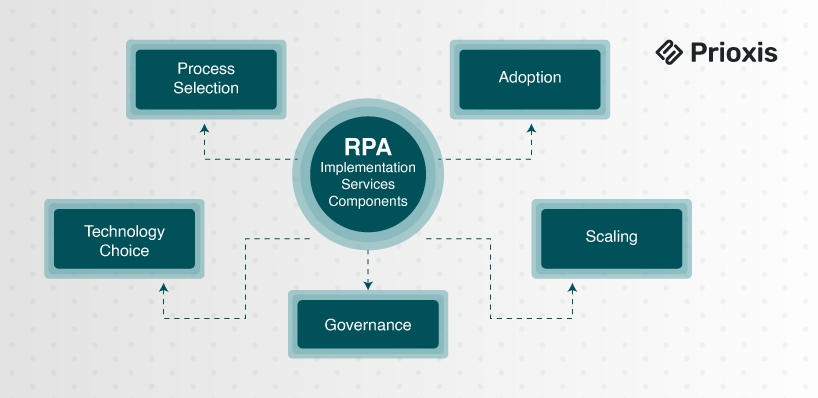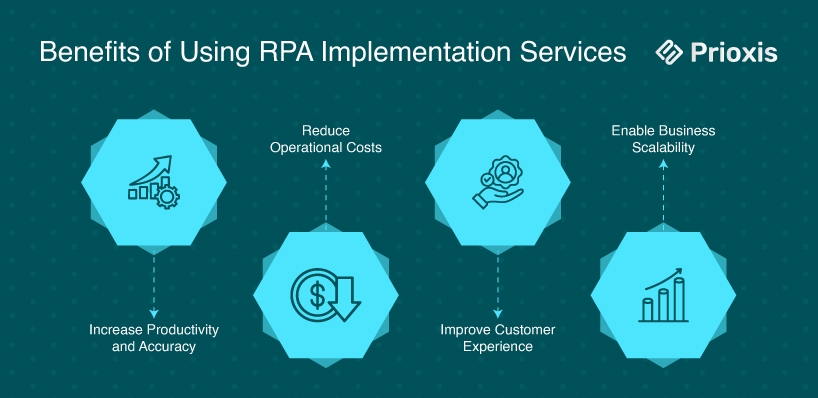
Table of Content
How much value is lost when skilled people spend their time on reporting, reconciliations, or approvals instead of strategy and growth? And what would it mean for your margins if those hours were redirected to higher-value work?
This is where robotic process automation creates impact. With the right implementation services, repetitive tasks are handled consistently by software bots, freeing your teams to focus on innovation and decision making. The return is not just lower operating costs. It shows up in faster reporting cycles, stronger compliance, and customer processes that can scale without bottlenecks.
This guide looks at the core components of RPA implementation, how to choose the right provider, and the steps that lead to a measurable return on investment in months rather than years.
Every business has processes that drain time and money. We help you pinpoint the right ones for automation, choose the right tools, and build a roadmap that shows clear ROI.
Robotic Process Automation is often explained as “bots mimicking human actions.” That definition is accurate but not useful for an executive. What matters is how it changes the economics of operations.
Across industries, the cost of manual processing is rising while error tolerance is shrinking. RPA directly addresses this gap. A mid-size bank, for example, cut KYC onboarding time by 50% with bots handling verification. A logistics firm processed three times more purchase orders without expanding staff. These are not efficiency tweaks, they are structural shifts that free budgets for growth.
The reason RPA has become a hot topic is that it pays back quickly. Unlike AI programs that take years of data preparation, RPA shows ROI in months because it automates what is already rule-based and well-documented. That early return makes it the gateway to broader digital transformation. Once leaders see measurable wins in compliance, reporting, or customer onboarding, they are more willing to fund advanced analytics and AI solutions.
In short, RPA is not about software mimicking humans. It is about reducing the hidden tax of repetitive work and building confidence that automation can scale responsibly.
A strong RPA program rests on a few essential components. Each one directly influences how quickly you see returns and how far the program can scale.

Selecting the right provider is often the difference between a pilot that fizzles out and an automation program that pays for itself. The following criteria help you evaluate partners in a way that cuts through surface-level promises.
Ask how many projects they have delivered in your industry and what measurable results came from them. A provider that understands regulatory constraints in finance, compliance demands in healthcare, or seasonal spikes in retail is less likely to make costly mistakes during deployment.
If a provider is formally partnered with UiPath, Automation Anywhere, or Blue Prism, they will have access to vendor-backed training and direct technical support. This shortens issue resolution times and gives you confidence that the automation stack you build will remain stable as new updates roll out.
Automation only delivers long-term ROI if your teams adopt it. Look for providers who include structured training and ongoing support as part of their service. This prevents reliance on external consultants every time a bot needs to be adjusted and helps your own staff take ownership of the automation journey.
Successful automation programs almost always follow a disciplined flow. Skipping or rushing a stage might get bots running faster, but it usually creates rework and higher costs later. These are the steps that keep implementations stable and ROI focused.
Every project starts with clarity in mind. Decide whether the aim is to reduce invoice processing time, cut compliance errors, or expand customer onboarding without adding headcount. Without clear goals, bots risk turning into isolated experiments instead of delivering measurable value.
It is tempting to automate everything at once. In reality, only some processes deliver meaningful returns. Repetitive, high volume, and rule based workflows such as payroll reconciliation or claims validation are usually the best starting point. Early wins here build momentum and justify further investment.
Enterprises already manage overlapping systems, legacy environments, and strict compliance policies. Choosing between UiPath, Automation Anywhere, or Blue Prism is not just about features. It is about which platform fits your IT stack, scales with your governance model, and has dependable vendor support.
Most processes look straightforward until you try to automate them. In practice, employees often handle exceptions without even realizing it. A bot will stop the moment it hits one of those cases. Running pilots in real conditions helps uncover those gaps before rollout and saves you from expensive fixes later.
Deployment is not the finish line. Ongoing monitoring highlights exceptions, workload peaks, and opportunities to extend automation. Strong programs have reporting and governance built in from the start so leaders can clearly see whether the automation program is meeting its business objectives.

RPA only makes sense if it helps you work faster, spend less, and serve people better. Here is what usually improves when automation is done right.
In many enterprises, 30-40% of staff time goes into repetitive, rule-based work. Bots handle this load without fatigue, which increases output per employee. Case studies show automated invoice processing is 60% faster compared to manual workflows whereas error rates are reduced by up to 70% in compliance reporting.
This shift frees skilled staff for strategy and analysis, where their time creates far more value.
Headcount expansion is the traditional answer to rising workload. RPA changes the equation. By automating reconciliations, approvals, and data entry, firms typically cut 20–30% of operational costs in targeted functions within the first year. The savings are not just payroll, but also fewer rework hours spent fixing errors.
Customers do not see “automation,” they see faster service. In banking, automated onboarding has reduced cycle times by 50%. In eCommerce, real-time order updates lower support calls. Accuracy and speed translate directly into better satisfaction scores and higher retention.
Growth normally brings higher cost. With RPA, the same process can handle two or three times the transaction volume without proportionally increasing staff. Logistics firms using automated order validation report 65% fewer manual touchpoints, making it possible to absorb seasonal spikes without extra headcount.
RPA does not add the same value everywhere. The business case shifts depending on regulatory demands, customer expectations, and cost structures.
Compliance, fraud checks, and reconciliation consume thousands of staff hours. Banks using RPA have reduced KYC onboarding times by up to 50% and cut compliance error rates by 70%. The value is not only efficiency but also lower regulatory risk.
Check out how insurance companies use RPA in their business operations
Accuracy in claims processing and patient records directly affects revenue cycles. Hospitals applying RPA have automated insurance verification and reduced claim denials by 30–40%, while freeing staff for patient-facing work.
Explore the transformative use cases of RPA in healthcare.
Order validation, returns, and supplier management are repetitive but time-critical. Retailers using bots for catalog updates and order tracking cut manual intervention by 65% and improved delivery accuracy during seasonal spikes.
High-volume order handling, inventory updates, and shipment tracking lend themselves to automation. RPA has enabled manufacturers to process purchase orders three times faster, while logistics providers handle fluctuating demand without scaling headcount.
Not every RPA platform delivers the same ROI. The choice depends on scale, compliance needs, and the kind of processes you want to automate.

UiPath stands out for ease of use and scalability. It is often the platform of choice for enterprises scaling from 10 bots to 500+ because of its strong orchestration layer and AI-assisted discovery tools. Companies in finance and healthcare use UiPath to cut process discovery time by up to 40%, accelerating ROI.
Website: www.uipath.com

Known for its cloud-native architecture, Automation Anywhere fits businesses that want lower infrastructure costs and faster rollouts. Its strength lies in quick deployment across distributed teams. Many mid-size firms report time-to-value in under 3 months because of its prebuilt templates and lighter IT footprint.
Website: www.automationanywhere.com

Blue Prism has a reputation for security and compliance-first design, making it a natural fit for highly regulated sectors like banking and government. Its governance model ensures bots run with strict audit trails. Large institutions cite 70% reductions in compliance exceptions after adopting Blue Prism for critical back-office workflows.
Here’s a detailed guide on how much it costs to implement the above-mentioned RPA platforms.
Website: www.blueprism.com
With Prioxis, identify the processes in your business that deliver ROI in weeks, not years. Our team helps you validate automation opportunities and build a practical rollout path.
The companies that succeed with RPA consulting are not the ones chasing big-bang transformations. They are the ones that start with a clear business case, prove results in weeks, and then expand with discipline. The payoff shows up in faster cycles, fewer errors, and teams that spend less time on low-value work.
RPA is not a silver bullet, but it is one of the few investments that can show measurable ROI in months instead of years. For executives, the real question is not “should we adopt it?” but “which processes will give us the fastest returns and how do we scale without losing control?”
At Prioxis, we have seen this play out across industries. From banks speeding up compliance checks to logistics providers handling seasonal peaks without extra headcount. Our approach has always been to design automation programs around business outcomes, not just technology. That discipline is what turns pilots into enterprise-scale results.
Get in touch